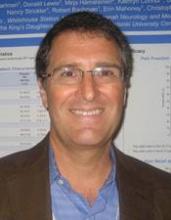LOS ANGELES – Rizatriptan is safe and effective when used for intermittent treatment of migraine in adolescents on a long-term basis, according to a year-long, multicenter, open-label trial presented at the annual meeting of the American Headache Society.
Less than 1% of the 606 patients studied experienced serious drug-related adverse events. And all of these events were classified as serious because they occurred after accidental use of an extra dose of rizatriptan in a 24-hour period.
Additionally, in 46% of treated attacks, the patients were pain free at 2 hours after taking the medication, reported lead investigator Dr. Eric M. Pearlman of Children’s Hospital at Memorial University Medical Center, Savannah, Ga.
"Rizatriptan was generally safe and well tolerated in the long-term acute treatment of migraine in this adolescent population," he maintained. And "at least in an open-label fashion, it was effective."
Session attendee Dr. James R. Couch of the University of Oklahoma, Oklahoma City, commented, "That’s a very impressive pain-free number. ... The usual triptan gives us between 25% and 30% pain freedom. Do you have any comments on why children seem to respond much better?"
"I think it was because it was open label," Dr. Pearlman replied. "But this was done in conjunction with a single-attack, double-blind, placebo-controlled trial," he added. That trial, which led to regulatory approval of the drug for adolescents, had a run-in phase aimed at identifying and excluding placebo responders; the rate of pain freedom at 2 hours was 31% with rizatriptan.
Dr. Pearlman and his colleagues studied 12- to 17-years-olds in the United States and Europe who met diagnostic criteria for migraine and had not achieved a satisfactory response to treatment with nonsteroidal anti-inflammatory drugs or acetaminophen.
They were assigned to the orally disintegrating tablet formulation of rizatriptan (Maxalt-MLT) based on weight: 5 mg if they weighed less than 40 kg, and 10 mg if they weighed 40 kg or more.
Patients were instructed to use the medication to treat up to eight migraines of any severity per month. But they also were told to use only a single dose of the medication in a 24-hour period (additional nontriptan rescue medication was permitted if necessary).
Overall, 23 patients were treated with the 5-mg dose, and 583 were treated with the 10-mg dose. The average age was about 13 years in the former group and 15 years in the latter group.
As far as migraine history, in the 3 months before the study, the patients had experienced on average four attacks monthly. The majority had migraines lasting more than 6 hours. Twelve percent were on preventive therapies. "For an adolescent trial, these are fairly disabling characteristics," Dr. Pearlman noted.
A total of 12,284 attacks (most either moderate or severe) were treated during the study. The mean number of doses of study medication taken by treated patients was 20.
The leading adverse event by far was accidental overdose (seen in 24% of patients overall), defined as taking more than one dose of rizatriptan in 24 hours. Possible reasons for these overdoses may have been previous experience with triptans for which two doses are allowed in this time period, and confusing a 24-hour day with a calendar day, Dr. Pearlman speculated. The next most common adverse events were dizziness (8%), somnolence (7%), and nausea (6%).
The rate of serious drug-related adverse events was 0% in the 5-mg group and 0.5% in the 10-mg group. "All three adverse events that were classified as serious occurred in the setting of an accidental overdose, and any adverse event that occurred in conjunction with an overdose per protocol was defined as serious," he explained.
In terms of efficacy, the rate of freedom from pain at 2 hours was 46% for all treated attacks, and it appeared to be consistent over time. In a post hoc analysis, the rate of pain relief at 2 hours was 65% for treated attacks. Rescue medications were used in only 6% of treated attacks.
Dr. Pearlman disclosed that he has received consulting fees from Merck, maker of Maxalt. The study was funded by Merck.


